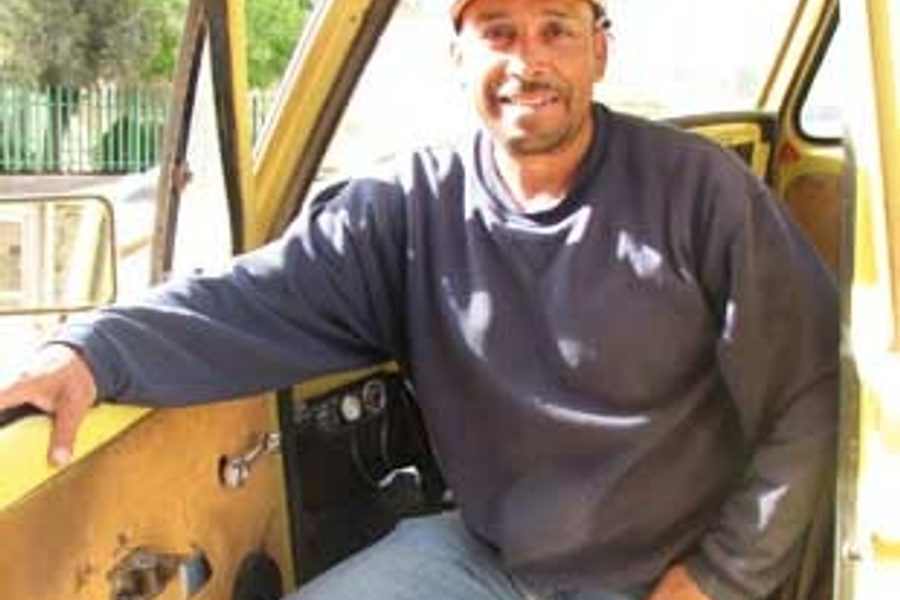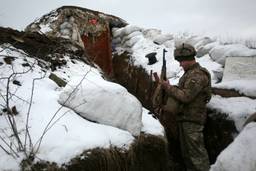Striking on the Shoulders of Giants
Injustice persists at copper mine that sparked Mexican Revolution
Kari Lydersen and Jessica Pupovac

CANANEA, Mexico – Jesus Verdugo was born in this hot, dry mining town nestled in the mountains of Sonora, about 25 miles south of the U.S.-Mexico border. A miner like his father, he grew up on the tract of land where the open-pit mine and town converge.
Cananea is home to Mexico’s largest copper mine. And Verdugo, 43, is the burly, charismatic, de facto leader of the local union – Section 65 of the Miners and Metallurgical Workers Union of Mexico (SNTMMSR). These days, his organizing entails driving his rickety, yellow pickup along winding rutted roads to check on striking copper miners who, in packs of 10 to 30, guard the various mine entrances, seven days a week. Yards away, members of a private security force (dressed in olive military garb and armed with billy clubs) lounge behind barricades of sandbags and a hurricane fence.
On July 30, 2007, Verdugo and 1,300 other workers went on strike, demanding safe working conditions, healthcare and recognition of the 70-year-old union’s elected leadership.
Cananea’s legacy
At the turn of the 20th century, Col. William Green, a U.S. citizen who owned the mine, paid his Mexican employees far less than his American workers. In 1906, the mine’s workers – organized by anarchist Ricardo Flores Mag – n – staged a strike that garnered support from the Industrial Workers of the World.
Green ultimately crushed the miners’ rebellion with help from Mexico’s then-dictator Porfirio Diaz and the Arizona Rangers, a law enforcement group formed to apprehend outlaws. But the Cananea strike – and the 30 Mexican and six American workers who died during it – became a rallying cry for the 1910 Mexican Revolution.
In 1971, Mexico nationalized Cananea’s massive copper mine. But in 1989, the government of the notoriously corrupt President Carlos Salinas de Gortari sold it for $525 million (in today’s dollars) to German Larrea, the scion of the multinational mining company Grupo Mexico, and currently the country’s third-richest man. His family’s estimated net worth is $7.3 billion. Their assets include not only mining interests in Mexico and Peru, but also Mexico’s largest railroad company and its second-largest movie theater chain.
Cuauhtémoc Cárdenas, then-leader of the leftist Democratic Revolutionary Party, called the sale a “clear aggression against workers.”
Miners and their supporters resisted Cananea’s privatization with widespread protests. But on Aug. 20, 1989, federal troops marched in. The mine was closed for three months, and when the union and company finally negotiated a re-opening, hundereds of jobs were cut, including that of Verdugo’s father.
The union says its bargaining power and strength have dwindled since privatization, and that workers in Cananea’s mine today suffer one of the highest accident rates in the country.
In April 2007, a study by the Berkeley, Calif.-based Maquiladora Health and Safety Support Network found “dozens of safety hazards on the site,” including disconnected dust collectors that allowed rock dust at 10 times the government’s legal limit. The dust causes silicosis – the terminal disease that killed Verdugo’s father.
The report also found electrical panels lacking protective covers; floors with gaping holes and no warning signs; and grease-slicked catwalks covered with hoses, which workers say have caused dozens of injuries and even death.
“The conditions were horrendous – the worst I’ve ever seen in my travels,” says Dr. Robert Cohen, an occupational respiratory health expert at Chicago’s county hospital, who visited Cananea in October 2007 as part of an international delegation of doctors and union workers.
A miner’s life
Decades ago, Verdugo’s siblings and relatives headed across the border to Tucson, Ariz., in search of better jobs. But Verdugo stayed in Mexico with his parents. He made it through the sixth grade, and shined shoes and sold newspapers to contribute to the family’s income.
In 1996, Verdugo got a job as an electrical mechanic in the mine. Two years later, the company threatened massive layoffs, and hundreds of miners went on strike. After three months, the federal Conciliation and Arbitration Board (CAB), declared the strike illegal, as it does most labor actions.
The workers refused to accept the CAB decision and Grupo Mexico threatened to call in federal troops to reopen the mine by force. It also promptly laid off and blacklisted 800 workers. The following year, it stopped funding the workers’ health clinic.
Tensions boiled over in February 2006, after an explosion at Grupo Mexico’s Pasta de Conchos mine – in the northern state of Coahuila – left 65 miners dead. The union’s General Secretary Napole – n G – mez Urrutia accused the company of “industrial homicide,” saying that the company had ignored workers’ continued complaints about dangerous gas leaks.
After the tragedy, the government charged G – mez Urrutia with fraudulent use of union funds. G – mez Urrutia, who denies the charges, fled to Canada, where he continues as union leader while fighting extradition.
The strike begins
The July 30, 2007, strike began as workers became fed up with dwindling benefits and poor safety standards. Miners at Grupo Mexico mines in Zacatecas and Guerrero – two Mexican states – staged simultaneous strikes. Less than two months later, the company closed its Guerrero mine. The strike continues at its Zacatecas mine.
Mexican labor law says work must stop during a legal strike, and workers have the right to control the facilities. But if a strike is ruled illegal, the company can forcefully reopen the facility and hire subcontractors.
In the beginning, the Cananea mine was shut down and workers maintained control. Union members hoped that by losing a reported $3 million a day in profits, Grupo Mexico would be pushed to the bargaining table. But on Jan. 11, 2008, arbitrators at CAB ruled the strike illegal, claiming workers didn’t follow proper procedure when they walked out.
In the predawn hours the next day, according to union leaders, helicopters began circling the town and hovering over union leaders’ homes. Video taken by union members and posted online show tour buses unloading police in riot gear, roads jammed with police trucks with flashing lights and, later, clouds of tear gas billowing through narrow streets.
According to strikers, police fired rubber bullets and beat union members, as snipers pointed guns from police helicopters. Miners report that police arrested and detained seven union miners and family members, including women and children. For weeks, federal and local law enforcement occupied Cananea. Workers have dubbed Jan. 11 “Black Friday.”
“[Police] detained and questioned our families as if we were narco-traffickers,” says Fernando Juvera, a union member.
On Feb. 14, a Mexican court overturned the CAB’s January ruling, allowing workers to continue the strike, but also allowing the company to continue operations. In March, federal safety inspectors visited Cananea, cataloguing the health and safety situation. Their report shows 265 violations, from lack of dust control to live electrical cables sitting in water.
Verdugo says Grupo Mexico has since made cursory improvements, but much work remains before he and fellow workers will return to the mine.
Shifting investments abroad
The soaring price of copper helped Grupo Mexico’s shares rise during the strike’s initial months, but by the second quarter of 2008 the company reported a 15.8 percent drop from the same period last year. Despite the company’s claims that the Cananea mine “has the longest remaining mine life of any major open-pit copper mine in the world, based on current production levels,” in late April, Grupo Mexico threatened to shutter the mine because of the strike. It offered strikers severance packages, but the majority refused, claiming the company cannot legally shut down a mine during an unsettled strike.
Company officials say they are now focusing on Peru. Grupo Mexico is a majority owner of Southern Copper Co., which is the name it operates under outside of Mexico.
But Peruvian workers have lodged similar complaints against the company. In mid-June, miners in Moquegua – a southern region of Peru – went on strike, calling for better wages and protesting a government proposal to reduce the amount of mining royalties paid to workers. More than 20,000 people blockaded streets, staged hunger strikes and held massive rallies. On June 26, Peru’s President Alan Garcia ordered local police to break up the demonstrations.
The Federation of Miners of Peru, which represents about 28,000 miners and 70 unions, soon joined the effort. In early July, the company accepted a general agreement that met the goals set by the Moquegua miners, although details are still being negotiated.
The Cananea miners see themselves, and their Peruvian counterparts, as engaged in a historic struggle for workers’ rights, akin to the one that made Cananea the cradle of the Mexican Revolution more than a century ago.
“The businessmen would like to do away with all unions,” says José Luis Minero, 64, who was 10 when his father was killed working in the mine. “But they underestimate us. We are doing this not just for our families, and not just for Cananea, but for workers everywhere.”
Out of 1,300 workers who initiated the strike, almost 1,100 remain.
“We have dignity, bravery, we’re in this together, and people from all over are supporting our struggle,” Minero added. “We can’t give in to the caprices of capitalism.”

I hope you found this article important. Before you leave, I want to ask you to consider supporting our work with a donation. In These Times needs readers like you to help sustain our mission. We don’t depend on—or want—corporate advertising or deep-pocketed billionaires to fund our journalism. We’re supported by you, the reader, so we can focus on covering the issues that matter most to the progressive movement without fear or compromise.
Our work isn’t hidden behind a paywall because of people like you who support our journalism. We want to keep it that way. If you value the work we do and the movements we cover, please consider donating to In These Times.




